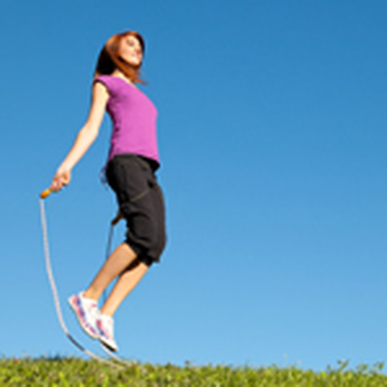
10 Quick Cardio Moves
1. Jumping JackStand with feet together, then jump, separating legs and raising arms overhead. Land with feet hip-width apart, then jump feet back together and lower arms. 2. Stair RunningRun up a flight of stairs, pumping your arms, then walk down. Vary by taking two stairs at a time. 3. Jumping RopeDo a basic boxer's shuffle or two-footed jump. Stay on balls of feet, not jumping too high off ground, elbows by your sides. 4. Squat JumpStand with feet hip-width apart. Bend knees and lower hips into a squat. Jump in air and straighten legs, lifting arms upward. Land softly, lowering arms. 5. Split JumpStand in a split stance, one foot a long stride in front of the other, then bend knees and jump, switching legs to land and pumping arms in opposition to legs. Alternate legs. 6. Step-UpStep up on a curb, stair, or sturdy bench with one foot, then the other, then down one at a time; repeat. 7. Alternating Knee LiftStanding tall, bring one knee toward your chest without collapsing rib cage; twist opposite elbow toward knee. Alternate sides. 8. Hamstring CurlStanding tall, step sideways with right foot, then bring left heel toward buttocks; pull elbows in to sides. Alternate sides. 9. Jog in PlaceJog in place, lifting knees up; swing arms naturally in opposition. Land softly, ball of foot to heel. 10. Side-to-Side LeapPlace any long, thin object (such as a broom) on floor. Leap sideways over object, landing with feet together. Find more stories like this on diets, fitness, healthy eating and recipes at Shape.com http://www.active.com/fitness/Articles/10-Quick-Cardio-Moves.htm?cmp=17-7-338
 Self-esteem in the athlete
Patrick Cohn explains why athletes must learn to separate self-esteem from their level of performance in sports
Many athletes and performers I work with often wrongly determine their self-worth by how successful they feel about their sport. When an athlete performs well or feels successful, he or she can feel good about him or herself. However, the opposite is also true: despair and low self-esteem results when this person does not perform well or view him or herself as a failure.
Check Out more for Zuzana Light on www.bodyrocks.tv
By Steven Aitchison Of http://www.stevenaitchison.co.uk/blog/ A few days ago, I filled out a VIA Survey of Character Strengths by Martin Seligman (Positive Psychology) and the results showed I was moderately optimistic. This gave rise to the topic ‘50 Ways To Build Your Optimism’. Optimism is simply anticipating the best possible outcome in any event. In no particular order here are ‘50 Ways To Build Your Optimism’. - Be realistic about your expectations.
- Accept the past, manage the present and work hard towards the future.
- Seek for a ray of light/hope in a negative situation. It’s a bit difficult considering all you are going through, but there’s always an opportunity lurking somewhere in the dark.
- Utilize what you have for now and aspire to grow in every area of your life, remembering you can only swallow food in bits and pieces before taking another big bite.
- Be authentic, be yourself and stop hiding behind the MASK of pretence.
- Get infected by being in a network or company of constructive people, because optimism is positively contagious.
- Have a dream, believe in it and do everything possible under the sun to run with it.
- Accept you are human with imperfections.
- Express love towards other people.
- Be selective of what you read, hear or watch from the media. Excessive media influence could dampen your spirits.
- Develop the habit of using positive affirmations constructively.
- Listen to music. It has the ability to make your mind wander a bit. Come on!!! dance to the groove; sing even if it won’t get you auditioned for XFACTOR.
- Exercise regularly. Taking care of your body mind and soul builds courage and resilience to face the pressures of the world.
- Avoid living in self denial.
- Try as much as you can to stay calm when overwhelmed with the issues of life.
- Be thankful for everything you have, who you are, the people around you…..
- Develop a sense of humour. Cultivate the habit of laughing or cracking jokes.
- Spoil yourself and make sure you enjoy doing so. Go on vacations, get a massage, eat out……..
- Improve yourself at the slightest opportunity you have. Your capacity to succeed in life will depend on your personal drive to take each opportunity as stepping stones to fulfilling your life long dream.
- Be gracious enough to accept things you cannot change. There will always be things you cannot change no matter how hard you work at it.
- Reflect and focus on the good things that have occurred in your life.
- Create a positive attitude.
- Don’t harbour any form of resentment particularly with issues from the past.
- Know when to call it quits. Some things aren’t just worth the effort and time you put into it.
- Occupy yourself with things that bring out the best in you i.e. family, children,friends, travelling, reading etc
- Focus on creating solutions and not drowning in problems.
- Be a positive role model to your children, friends, family etc. Be a source of inspiration to people who look up to you.
- Be good at your job demonstrating your useful skills.
- Have a hobby to keep you occupied. It could be a form of sport, reading, writing etc.
- Improve your physical appearance when necessary.
- Get some rest because it is required to put things in perspective.
- Learn something new in order increase your knowledge.
- Be passionate. Embrace life and everything it stands for with love and passion.
- Show persistence in all your endeavours because it’s one of the keys to happiness.
- Worry less because it reduces the level of your anxiety..
- Celebrate the successes of other.
- Be determined and motivated to excel in all you’ve set out to do.
- Learn to try out new things.
- Maximize your success and give attention to your failures remembering that failures are learning experiences that yield positive results if handled properly.
- Set a goal so that you will have something to look forward to when the going gets rough.
- Practice the habit of forgiveness.
- Avoid clutter. Be organized not only with your things but also with your thoughts and your plans.
- Create a positive environment in your home or office.
- Read several motivational stories, blogs,quotes….
- Think positively about who you are.
- Develop a strong ambition.
- Visualize happy thoughts. Imagine a picture in your mind what you want to achieve and how you can achieve them. Oftentimes, what you create in your thoughts give birth to what happens in reality.
- Walk tall, with your head high up exhibiting confidence.
- Smile as often as you can. It has a way of showing your sincerity.
- Have a blend of optimism in the way you pick, choose and say your words.
http://www.stevenaitchison.co.uk/blog/2009/10/16/50-ways-to-build-your-optimism/
 By Patrick Cohn, Ph.D. and Lisa Cohn Why do athletes sabotage their own success? You might assume this problem relates to a "fear of success." Fear of success does cause athletes to self-destruct. But fear of success is very rare compared to fear of failure. Both of these fears cause athletes to "get in their own way"--experiencing fear, anxiety, tension and worry about scoring and achieving results. However, these fears come from different sources. You Can't Always Get What You Want Athletes develop a fear of failure when they worry about not getting what they want and have worked hard to obtain, such as winning a championship. They develop fear of success when they worry too much about what comes with being successful in their sport. Most athletes experience fear of failure and not fear of success. Fear of failure manifests in many ways in sports. Athletes who are anxious or tense when competing are often afraid to fail or mess up. Fear of failure can also cause your athletes to try too hard, which leads to "getting in their own way" mentally. Diagnosing Fear of FailureIt's not enough to know that athletes experience a fear of failure. What's more important is to know what types of fears hold athletes back. As you can see from the list below, fear of failure often relates to what athletes assume they think others think about them (or social approval). Signs of fear of failure: - Fear of losing a match, game or race. Kids badly want to win and are afraid they won't succeed.
- Fear of negative social evaluation. Athletes fear others will view them as a failure in sports.
- Fear of embarrassment. They're afraid to embarrass themselves in front of others if they don't perform well.
- Fear of letting others down. They do not want to let others down-- coaches, parents or teammates.
- Fear of putting in the effort and not ever getting the "payoff" or not playing to their potential. They don't want their hard work, talent and long
- practices to result in nothing (e.g. wins, trophies, etc.).
- Fear of not performing up to others' expectations. Young athletes worry about not meeting others' expectations.
- Fear of being rejected, losing respect, or not gaining approval.
- Fear of making mistakes and not performing perfectly after having worked so hard.
Helping Athletes Overcome Fear of Failure - To help kids with fear of failure, it's best to understand the specific fear and address it head on. Take fear of embarrassment, for example. If your athletes have this form of fear they worry too much about what others think about them. They need to play for themselves instead of being concerned about what others think.
- Help kids focus on success instead of worrying about failing. Many athletes with fear of failure focus on all the wrong things. They think more about not making mistakes than completing the pitch or gymnastics routine. These athletes need to set small goals that help them focus more on success. One option: kids should see a good result in their minds before they execute it.
- Athletes with fear of failure need to learn how to perform efficiently instead of perfectly. The idea here is that your athletes DO NOT have to be perfect to perform their best. They often want to over control their performance (due to their worries about making mistakes). They need to understand that mistakes are a natural part of sports. The goal is for your athletes to trust in their skills so they can play more freely and feel less tight or controlling.
Award-winning parenting writer Lisa Cohn and Youth Sports Psychology expert Dr. Patrick Cohn are co-founders of The Ultimate Sports Parent. Pick up their free e-book, "Ten Tips to Improve Confidence and Success in Young Athletes." http://www.active.com/mindandbody/articles/How-to-Conquer-Fear-of-Failure.htm?cmp=17-7-323

By Mike Howard on Sep 17, 2010
All the traps and pitfalls in life, self esteem is the deadliest and hardest to overcome. For it is a pit designed and dug by our own hands, summed up in the phrase: It is no use, I cannot do it ~ Maxwell MaltzAccording to some psychologists, self-esteem is the center of it all - THE most prominent factor when it comes to success in any health pursuit.
In any case, a struggle with self-esteem may be the sticking point you need to get past in order to succeed in your health goals. So, here are 10 ways to flex your self-esteem muscles.
- Stop comparing yourself to others: This can be detrimental to your self-image and only serves to de-value who you are as an individual - a unique and wonderful individual.
- Always accept and appreciate compliments: Try not to downplay or reject compliments from others. The ability to receive is a hallmark of self-efficacy.
- Accept VALID criticism from those you trust: This may sound counterintuitive, as criticism can be the source of self-esteem issues, however feedback from those who are close to you should be accepted and appreciated just as compliments should.
- Make a list of a) Your good qualities (kind, thoughtful, organized, etc.) b) Your hobbies (knitting, scrapbooking, decorating, etc). c) Things you are good at (car maintenance, scrabble, Sudoku, etc). This exercise will help re-enforce your qualities and aptitudes, which will in turn infuse some confidence.
- Avoid making your problems the centerpiece of your conversation:Talk positively about your life and what you are working towards. Try and be aware of negative self-talk, take notice of how often you complain.
- Set achievable goals: Write them down and take small steps towards achieving them. Celebrate and reward your successes along the way (not with food, though).
- Use positive affirmations and tools: Ingraining positive thoughts often means repeating them often. Write them down and put them somewhere where you'll see them. Say things such as; "I am loved", "I am positive, motivated and liked", "Today is a great day to be alive", etc.
- Help others: Volunteering your time to help others in some way just plain feels good. Use these feelings as a motivator for your other actions in life.
- Surround yourself with positive and uplifting people: Misery loves company and negativity begets negativity. Find circles of friends who love to laugh, keep things positive and are generally pleasant to be around. Peer groups are important for adults just as they are for children and teens.
- Take responsibility: While negative self-esteem can be very limiting at times, taking a "woe is me" approach will only serve to keep you in the spiral of negativity and inaction. You and only you can choose to take action to better yourself, so commit to it, and take the necessary steps to reach your goals.
Do you have any tips for building self-esteem? How do you stay confident? If you feel you lack self-esteem, what do you think is holding you back?
Important note: Negative self-esteem may be a symptom of depression or other psychological disorders. Seek appropriate help if needed.
Image Credit: schadenfreude http://www.diet-blog.com10/building_self-esteem_to_conquer_your_goals.php
 By Matt Fitzgerald
For Active.com
Unless you've been living in a cave, you've probably seen those television advertisements in which a leading sports drink maker claims its product "hydrates better than water." The fact that the message of these ads hasn't changed in many years suggests that a lot of athletes aren't buying it. But it's actually true.Why do sports drinks hydrate better than water? There are three reasons. First, fluids are absorbed through the gut and into the bloodstream faster when their osmolalityclosely matches that of body fluids such as blood.
Osmolality is the concentration of dissolved particles in a fluid. Sports drinks contain dissolved minerals (sodium, etc.) and carbohydrates, whereas water doesn't, so water doesn't reach the bloodstream as quickly.
Sodium and other nutrients also play important roles in regulating fluid balance in the body. In other words, they help determine how much fluid enters into muscle fibers and other cells, how much remains in the blood, and so forth. Again, because sports drinks contain these nutrients, they do a better job of allowing the body to maintain optimal fluid balance, which is an important aspect of hydration that few athletes consider.
A third advantage of sports drinks over water with respect to hydration is that the sodium content of sports drinks stimulates thirst, so athletes usually drink more when they have a sports drink than when they have plain water.
Choosing the Right Sports Drink
Not all sports drinks hydrate equally. Those that contain higher amounts of sodium are preferable, because they are absorbed quicker and maintain fluid balance in the blood and muscles better. Choose a sports drink that contains at least 15 mg of sodium per ounce.
New research suggests that sports drinks containing a small amount of protein may also hydrate better than conventional sports drinks. Protein is an often-overlooked nutrient that affects osmolality just as minerals and carbs do. Therefore the addition of protein to a sports drink has the potential to increase its absorption rate.
This was demonstrated in a recent study by exercise physiologists at San Antonio Catholic University in Murcia, Spain, and published in the Spanish Journal of Nuclear Medicine.
Twenty-four well-trained cyclists participated in the study. They were fed either of two sports drinks at rest and during a workout. Drink A was a conventional sports drink containing 15 grams of carbohydrate per 100 ml. Drink B contained 10 grams of carbohydrate per 100 ml plus proteins.
After 60 minutes of exercise, the researchers found that a significantly greater amount of drink B, containing carbs and protein, had been absorbed than drink A. These results indicate that a carb-protein sports drink may hydrate better than a conventional sports drink.
The addition of protein to a sports drink appears also to aid fluid retention. When a beverage is too dilute, it tends to pass quickly through the bloodstream to the bladder so it doesn't "water down" the blood and other body fluids.
New evidence suggests that the right amount of protein in a sports drink, in combination with the right amount of carbs and electrolytes, may boost fluid retention and help you hydrate better during exercise.
In a new study from St. Cloud State University, cyclists exercised until they lost two percent of their body weight and then consumed one of three beverages: a sports drink containing carbohydrate and protein in a 4:1 ratio; a conventional sports drink containing carbs and electrolytes but no protein; or water.
Over the next three hours, the investigators measured how much of each beverage was retained. Only 53 percent of the water was retained, versus 75 percent of the conventional sports drink and an amazing 88 percent of the carb-protein sports drink.
Other Advantages of Sports Drinks
Sports drinks have other advantages over water for athletes and exercisers that go beyond better hydration. Specifically, the calories in sports drinks have been shown to increase energy and endurance, limit the immune system suppression that sometimes follows hard workouts, reduce exercise-induced muscle damage, and promote faster recovery.
Water is by far the most popular fluid choice during exercise. However, sports drinks actually do a better job of hydration, while also providing other benefits that water does not. Water is a great drink choice outside of workouts, but during exercise you're much better off with a sports drink. In this case, there's truth in advertising.
This article was adapted by the author from The Cutting-Edge Runner: How to Use the Latest Science and Technology to Run Longer, Stronger, and Faster (Rodale). Clickhere to purchase a copy. http://www.active.com/running/Articles/Which_fluid_hydrates_best__Water_or_a_sports_drink_.htm?cmp=17-7-313
 Today is officially Day Light Savings and our son Drew's Birthday. Happy Birthday Drew! So the past couple of days have been filled with needed clarity with my overall fitness goals. It's a blessing that I've come to understand that the goals I have made for myself and the progress that I've been making is merely just the beginning of my new lifestyle change.
It's apparent to me know that I've finally broke the hump of my dreadful workouts and with the anxiety gone I've finally found my stride. It's freaking about time. I now look forward and yearn for my next workout. I yearn to explore more and more ways I can push my body to it's limit. I challenge my knowledge of fitness and health daily by reviewing a diverse compilation of fitness blogs and articles.
Saturday was my first attempt at Intense Cardio and I must honestly say it wasn't easy and I'm already feeling the wrath of jump squats in my legs. But to my dismay I'm actually more in tune with my body now then I have ever been. I do enjoy the challenge and the increase of adrenaline that working out so intensely brings.
Just recently I injured my knee, had aching pains in my shoulder and the overall discomfort has been swaying of my dedication to improve my overall health. I do feel better and I've been doing much better at getting up early and getting my workouts out of the way, so I can battle the rest of my day without distraction. I do hope that I can continue to work on maintaining proper form and technique to prevent any future injuries.
My past few days in the gym have been good, but I've come to realize that if I'm going to accomplish the results that I seek I must Intensify my cardio routines.
Yes I have been consistent and deliberate with both my resistant and cardio workouts. I also have been very strict with my overall caloric intake and food choices, but I'm not seeing the results I yearn for. My decision is to challenge my overall body and start doing what is proven to work. Intense Cardio! I'm doing my time on the treadmill and my only results are stamina and endurance, and not very much FAT loss.
For me to see the desired results, I need too introduce intense workouts like P90x, Insanity, Suicide Sweat and Kelly Rennie Home Workout. Below I posted a sample video of what I'm referencing as an intense cardio workout. As you can see I chose the Suicide Sweat Workout because frankly she's hot and it's motivational too me. We all need to find our own source of motivation, and here's mine. WARNING WHILE WATCHING THIS VIDEO AROUND MIXED COMPANY
I DIDN'T REALIZE UNTIL I POSTED IT THAT SHE'S WORKING OUT HARD AND MAKING GRUNTING NOICE'S, SO MY 15 YEAR OLD SON SAY'S "Sooooo Dad What's ya whachin". Watch it and you'll get it!
All four of these workouts are very similar and the most un-nerving part for me is it is a DO IT AT HOME WORKOUT. Not good for me, I have zero motivation to workout at home. I guess it's all the distraction of parenting that makes me seek my motivation in the gym. The gym offers me a place to relax, a place to focus on myself and my goals.
In the past few days Shannon and I have been playing around with a few different intense cardio workouts and we have found that we will build our workouts from examples of the proven P90x, Insanity, Suicide Sweat Workout and Kelly Rennie home workouts.
So in the next few weeks to come I will be posting our challenges and struggles with these workouts, but the truth here is were going to get our asses kicked and not only get in better physical condition but improved overall health.
I must admit I have extremely weak legs for continuous, high rep leg workouts. I'm kind of a sissy when it comes to lunge like workouts that the girls at the gym can do over and over. It's time I man up and challenge my ego and pride to overcome this weakness of mine.
I haven't done much Intense Cardio for any prolonged period of time since I was in high school sports; So what I've learned so far is Intense Cardio has basic principles that don't change no matter what Intense Cardio workout your doing. " IF YOU DON'T DO THE WORK, YOU WON'T GET THE RESULTS ". Simple isn't it. Intense Cardio offers a no excuse method of burning fat. You don't need much space, you don't need a gym ( except in my case), you don't need weights or any special equipment or gear. All you need is the will to succeed and the determination to be consistent. Second, change it up frequently to keep the body guessing so your body doesn't adapt to any routine.
Most workouts will say and preach 30 minutes a day 3 days a week to lose weight. Hmmmm Well that hasn't been true for me and when I ask trainers and instructors at the gym; they all tell me you need at least 45 minutes 3-5 days a week. The more you do the better the fat burn. It's obvious to me that the body I seek can only be obtained by sweat and tears. My hard hard hard work is the only way to get me there. No FAD diet or casual routine will do, ONLY proven methods of 6 days of Intense Cardio work.
It's a tough getting to the gym at 5am, I must say that it's much easier working out then getting out of bed. Today's workout was good. We completed a full back workout and 20 minutes on the stationary bike. It was a high intensity workout, but hopefully I will get accustomed to the time and be able to kick things up a bit. I have been working hard on my food intake and replacing more protein shakes for actual food.
I'm an eater, so it's hard to drink my food. So far I haven't been overly hungry, but hopefully I'll be able to keep my lean muscle and drop a few pounds. I'm eating a small lunch and a sensible dinner and everything in between is a protein shake filled with protein powder of course, yogurt, fiber, coconut oil, and lactose free milk.
I'm currently not taking any other supplements besides protein and vitamins, so I hope to stay that way till I hit a plateau. Short and sweet blog tonight, cause frankly I'm tired.
|












 RSS Feed
RSS Feed







